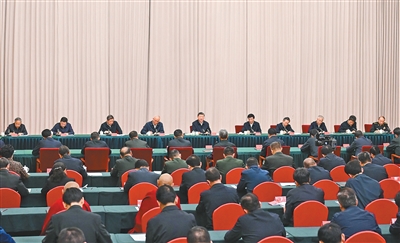Xi Jinping Stresses During Work Report Hearing by Tibet Autonomous Region Party Committee and Government
|
On the afternoon of August 20, Xi Jinping, General Secretary of the Communist Party of China Central Committee, President of the State, and Chairman of the Central Military Commission, who led the central delegation to attend the celebration of the 60th anniversary of the establishment of the Tibet Autonomous Region, listened to the work report of the Tibet Autonomous Region Party Committee and government in Lhasa and delivered an important speech. |
On August 20, Xi Jinping, General Secretary of the Communist Party of China Central Committee, President of the State, and Chairman of the Central Military Commission, who led the central delegation to attend the celebration of the 60th anniversary of the establishment of the Tibet Autonomous Region, listened to the work report of the Tibet Autonomous Region Party Committee and government. He emphasized that Tibet must fully implement the Party’s strategy for governing Tibet in the new era, adhere to the general principle of seeking progress while maintaining stability, fully, accurately, and comprehensively implement the new development philosophy, solidly promote high-quality development, continue to thoroughly address the four major tasks of stability, development, ecology, and border strengthening, and strive to build a new socialist modern Tibet that is united, prosperous, civilized, harmonious, and beautiful.
Xi Jinping pointed out that over the 60 years since the establishment of the Tibet Autonomous Region, under the strong leadership of the Party Central Committee and with the strong support of the people across the country, the Party Committee and government of the autonomous region have united and led the people of all ethnic groups in the region to work hard and forge ahead, upholding and improving the system of regional ethnic autonomy, deeply carrying out the anti-secession struggle, achieving remarkable major accomplishments in economic and social development, and witnessing earth-shaking changes on the plateau. Together with the rest of the country, Tibet has completed building a moderately prosperous society in all respects as scheduled and embarked on a new journey to fully build a modern socialist country. On behalf of the Party Central Committee, he extended warm congratulations and sincere greetings to the cadres and people of all ethnic groups in Tibet!
Xi Jinping emphasized that governing, stabilizing, and prospering Tibet must first ensure political stability, social stability, ethnic unity, and religious harmony in Tibet. It is necessary to further strengthen the sense of community of the Chinese nation and promote the construction of the Chinese national community, strengthen education and propaganda on the history of the Party, the history of New China, the history of reform and opening up, the history of socialist development, and the history of the development of the Chinese nation, widely publicize the brilliant achievements of the Tibet Autonomous Region over the past 60 years, tell the story of Tibet in the new era well, and guide cadres and people of all ethnic groups to continuously enhance the “five identities.” It is necessary to actively create a national model zone for ethnic unity and progress, promote and popularize the national common language and script, promote exchanges and integration among all ethnic groups, and promote two-way economic, cultural, and personnel exchanges between Tibet and the inland. In accordance with the requirements of systematically advancing the sinicization of religion in China and strengthening the rule of law in the governance of religious affairs, it is necessary to guide Tibetan Buddhism to adapt to the socialist society. It is necessary to strengthen Party building leadership, improve the social work system and mechanism, better serve and unite the masses, and consolidate the foundation of social governance.
Xi Jinping pointed out that Tibet’s development has its own characteristics, and it is necessary to promote high-quality development based on reality. It is necessary to develop plateau-specific advantageous industries according to local conditions, especially characteristic agriculture and animal husbandry and clean energy industries, continue to develop resource processing industries, actively develop modern service industries, and promote the integration of cultural and tourism industries. It is necessary to promote the construction of major projects such as the Yarlung Tsangpo hydropower project and the Sichuan-Tibet Railway in a powerful, orderly, and effective manner. It is necessary to strengthen ecological civilization construction, synergistically promote carbon reduction, pollution reduction, green expansion, and growth, and protect the “Roof of the World” and the “Asian Water Tower.” It is necessary to coordinate the promotion of new urbanization and comprehensive rural revitalization, consolidate and expand the achievements in poverty alleviation, solidly carry out livelihood work such as employment, education, medical and health care, social security, elderly care, and childcare, and



